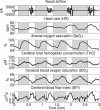How does obstructive sleep apnea alter cerebral hemodynamics?
- PMID: 37336476
- PMCID: PMC10424168
- DOI: 10.1093/sleep/zsad122
How does obstructive sleep apnea alter cerebral hemodynamics?
Abstract
Study objectives: We aimed to characterize the cerebral hemodynamic response to obstructive sleep apnea/hypopnea events, and evaluate their association to polysomnographic parameters. The characterization of the cerebral hemodynamics in obstructive sleep apnea (OSA) may add complementary information to further the understanding of the severity of the syndrome beyond the conventional polysomnography.
Methods: Severe OSA patients were studied during night sleep while monitored by polysomnography. Transcranial, bed-side diffuse correlation spectroscopy (DCS) and frequency-domain near-infrared diffuse correlation spectroscopy (NIRS-DOS) were used to follow microvascular cerebral hemodynamics in the frontal lobes of the cerebral cortex. Changes in cerebral blood flow (CBF), total hemoglobin concentration (THC), and cerebral blood oxygen saturation (StO2) were analyzed.
Results: We considered 3283 obstructive apnea/hypopnea events from sixteen OSA patients (Age (median, interquartile range) 57 (52-64.5); females 25%; AHI (apnea-hypopnea index) 84.4 (76.1-93.7)). A biphasic response (maximum/minimum followed by a minimum/maximum) was observed for each cerebral hemodynamic variable (CBF, THC, StO2), heart rate and peripheral arterial oxygen saturation (SpO2). Changes of the StO2 followed the dynamics of the SpO2, and were out of phase from the THC and CBF. Longer events were associated with larger CBF changes, faster responses and slower recoveries. Moreover, the extrema of the response to obstructive hypopneas were lower compared to apneas (p < .001).
Conclusions: Obstructive apneas/hypopneas cause profound, periodic changes in cerebral hemodynamics, including periods of hyper- and hypo-perfusion and intermittent cerebral hypoxia. The duration of the events is a strong determinant of the cerebral hemodynamic response, which is more pronounced in apnea than hypopnea events.
Keywords: cerebral hemodynamics; diffuse correlation spectroscopy; near-infrared spectroscopy; obstructive sleep apnea; sleep disorder.
© The Author(s) 2023. Published by Oxford University Press on behalf of Sleep Research Society.
Figures





References
Publication types
MeSH terms
LinkOut - more resources
Full Text Sources
Medical

